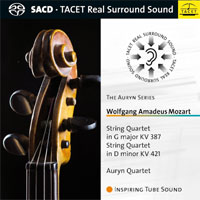Mozart • String Quartet in G Major KV 387, String Quartet in D Minor KV 421 Auryn Quartet  oday, for the classical-music aficionado, hearing a string quartet
is about as common as breathing. The string quartet is a major part of the classical
repertoire, and most composers from the Romantic period onward have written for string
quartets, leaving a veritable smorgasbord of music to enjoy. However, such was not the
case when Mozart lived. In his day, the string quartet was in its birthing stages, Joseph
Haydn having written the first set of string quartets only a few years prior. At the time,
no one knew what to make of, or what to do with, the idea of two violins, viola and cello
as a group. Mozart knew of Haydn's efforts, the two being friends despite the rather large
age difference. oday, for the classical-music aficionado, hearing a string quartet
is about as common as breathing. The string quartet is a major part of the classical
repertoire, and most composers from the Romantic period onward have written for string
quartets, leaving a veritable smorgasbord of music to enjoy. However, such was not the
case when Mozart lived. In his day, the string quartet was in its birthing stages, Joseph
Haydn having written the first set of string quartets only a few years prior. At the time,
no one knew what to make of, or what to do with, the idea of two violins, viola and cello
as a group. Mozart knew of Haydn's efforts, the two being friends despite the rather large
age difference.
So it should come as no surprise that when Mozart became serious about writing his own string quartets, he would dedicate his second set to his dear friend and stylist of the genre, Haydn. It’s from that second set, the Haydn Quartets, as they are called, that these two selections come. It should also be no shock that when these were released, they set a standard for the string quartet. Haydn himself, upon hearing them, looked at Mozart’s father Leopold and said, "Before God and as an honest man, I tell you that your son is the greatest composer known to me, either in person or by name. He has taste, and, furthermore, the most profound knowledge of composition." Quite a compliment from one of the great composers of music during the Classical period. Mozart wrote the String Quartet in G Major (KV 387) in 1782 and the String Quartet in D Minor (KV421) the following year, when he was all of 26 and 27. These were the first two of the set of six quartets he dedicated to Haydn, and unlike his first efforts this set owed its inspiration to no one, not even Haydn. Mozart took his efforts so seriously that we still have examples of the changes and rewrites he made to these two quartets today. As with everything Mozart turned his hand to, it boggles the mind to consider what he might have accomplished had he not died so young. Still, these quartets display a full sense of drama, tension and power, and a mature understanding of just what the string quartet was capable of. But above all else are the love of life and the joy that infused all of Mozart’s compositions. The Auryn Quartet melds its sound about as well as can be expected, perhaps because the four founding musicians from 1981 -- Andreas Arndt on cello, Stewart Eaton on viola, and Matthias Lingenfelder and Jens Oppermann on violin -- still comprise the group to this day. You don’t play together for over 37 years without becoming almost a single entity. Tacet, with its use of tube microphones, captures the playing of the Auryn Quartet nigh on perfectly. The violins soar, the cello's deeper sonorities anchor the music, and the viola straddles the space between the two. Tacet's production has the quartet sitting in a square or circle, so the members can face each other, allowing for sight as well as ear to create synergy. This configuration also lends itself to multichannel recording, which has become a Tacet specialty of late, as it places the musicians all around the listener in more a more natural manner. If I had to pick a nit regarding this recording it would be that the tempo is a little more measured than I prefer. However, as in everything in life, there are tradeoffs, and in this case the sound is so exquisite that I’ll trade what I hear as a slight slowness in tempo for the richness and detail afforded the two violins, viola and cello. If you’ve never heard a Tacet recording, you are
doing yourself a disservice. I have yet to hear one that I don’t consider at or near
the apex of the recorded arts. This album presents music that will serve you well on those
slow-to-dawn Sunday mornings, or as a gentle bring-me-down after a long day at work. But
don't play this album unless you’re prepared to sit down and listen all the way
through. Its sound will simply draw you in and make thoughts of anything else flee your
brain as it immerses you in the beauty of these exquisite compositions. |
